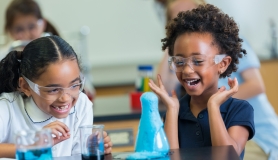A few years ago, as a newly qualified Montessori early years teacher and a brand new parent, I was adamant I would raise The Perfect Montessori Child. Over the years I rotated trays of sensorial materials, sourced overpriced knobbed cylinders and golden beads for counting. I bought seemingly hundreds of tiny china jugs from charity shops and encouraged my toddler to pour water from one to another.
Creating the Right Environment
The house began to resemble a Montessori classroom, albeit one that was impossible to sustain. On Day One the interest table would be a perfectly curated display on the Topic of the Week, complete with materials designed as an invitation to play.
By Day Two it was covered with an array of soft toys, crayons and half the contents of the crafts box.
I got tired of maintaining it all, and my husband made it increasingly clear there were only so many broken shards of china jugs he was willing to hoover up each day. I admitted defeat – my home could never be the Montessori classroom I had so desperately wanted.
Montessori Approach: Follow the Child
What on earth was I thinking? The Montessori method was originally designed to be used by children without access to a traditional classroom. The activities were devised to enable under-privileged children to utilise their different senses and awaken a world of curiosity within them. To provide them with the opportunity to develop practical life skills that allow them independence and autonomy. To foster a sense of wonder and purpose in the incredible world we live in.
The materials were just a way to spark that curiosity. Parents who encourage their toddlers to pour, mix, build, and explore will help spark that love for learning, without needing to spend a fortune on the pink tower blocks and number rods. The principle of ‘follow the child’ is often intuitive – watching how your child interacts with activities and objects and where their interest lies.
I still have to resist the urge to buy those beautiful wooden jigsaw puzzles and have to sit on my hands to not purchase every printable I see on Pinterest. Instead, I make myself revisit my notes from when I was an eager Montessori student and imagine what Maria Montessori envisioned when she was devising her method for disadvantaged children over a century ago. And I get us outdoors.
Guardians of the Natural World
Outdoors is no longer a strange notion to parents and teachers, but a hundred years ago it was faintly horrifying to think of children encouraged to explore outside in the mud and the dirt. Yet this was often the environment her young pupils occupied, without choice. She encouraged them to learn about the natural world around them, believing that to foster a sense of responsibility would allow them to become citizens of the world – guardians of their environment, and careful custodians of their little section of the earth.
I bear this in mind every time I see another rotten weather forecast and curse the prices of local attractions. I remember that every well-trodden trip for me to the adjacent common is, for my young child, a foray into the wilderness. A chance to explore and examine under different conditions a vast array of insects, tracks, leaves, temperatures, light, signs and colours.
Each time I stand in the woods with icy rain dripping down my neck, instead of imploring my child to head home with me I force myself to look – really look – at what’s around me. Instead of Montessori’s sequence of sensorial materials, we use what’s around us in the woods and fields.
Literacy is literally everywhere in terms of developing vocabulary and descriptive language for what we see, smell, hear and feel. Numeracy skills are developed through counting, drawing fractions in the dirt, addition and subtraction of pinecones and conkers. We explore the ecosystem by investigating what grows in the leaves and what insects burrow in the bark. We study the life cycle of a tree, and take photos of an oak as it changes through the weeks and months. We stop, and observe closely the tiny corner of the world in which we live.
I’ve learned to practice the Montessori method mindfully, and concentrate on the resources we do have available, rather than those in the classroom.
Get more Anne-Sophie!
www.imperfectly-montessori.com
Twitter: Imperfectly Montessori @followthechild1







